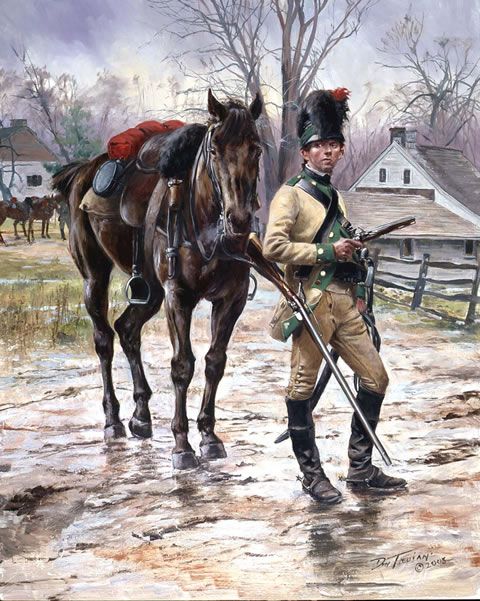Lee’s Legion[1] had its origins in Washington’s recommendations to Congress of 11 October 1780. Washington wrote, ‘‘Tho’ in general I dislike independent corps, I think a partizan corps with an army useful in many respects,’’ referring to such duties as reconnaissance, skirmishing with enemy light forces, and general camp and march security (Fitzpatrick, Writings, 20, p. 163). He went on to recommend the creation of two of these highly mobile, mixed units of infantry and cavalry and nominated Charles Armand and Henry Lee to command them. On 21 October, Congress accepted Washington’s recommendations. It promoted Major Henry (‘‘Light-Horse Harry’’) Lee of Virginia to lieutenant colonel and transformed his corps of four mounted troops of partisan light dragoons into a legion of six fifty-man troops, three mounted and three dismounted (the equivalent of light infantry). Lee carefully selected his officers and men from other units of the army, ‘‘the officers with reference only to their talents . . ., and the men by a proportionable selection from the troops of each State enlisted for three years or for the war’’ (Lee, Memoirs, pp. 17, 29–30). When the unit reported to Major General Nathanael Greene on 8 January 1781 at the southern army’s camp on the Peedee River in South Carolina, the Legion numbered 100 horse and 180 foot.
Lee and his green-coated Legion rendered important service in the South. They earned accolades from their contemporaries (and respect from their opponents) for their ability to move fast and hit hard, and gave Greene a disciplined, well-equipped, and well-mounted force that could operate either with the main army or with the less well-endowed militias of Andrew Pickens, Thomas Sumter, and Francis Marion. Historians have also been impressed. According to the editors of the Greene papers, ‘‘Lee performed brilliantly in the South. As Nathanael Greene’s most trusted subordinate, he enjoyed great autonomy’’ (Showman, Greene Papers, 6, p. 431). The structure and personnel of the Legion enabled Lee to use his talent as a leader of light troops to best effect. The Legion was disbanded at Winchester, Virginia, on 15 November 1783.
BIBLIOGRAPHY Fitzpatrick, John C. The Writings of George Washington. Vol. 20, September 6, 1780–December 20, 1780. Washington, D.C.: U.S. Government Printing Office, 1937. Lee, Henry. Memoirs of the War in the Southern Department of the United States. Edited by Robert E. Lee. New York: University Publishing, 1869. Showman, Richard K., et al., eds. The Papers of Nathanael Greene. Vol. 6, 1 June 1780–25 December 1780. Chapel Hill, N.C.: University of North Carolina Press, 1991. Wright, Robert K., Jr. The Continental Army. Washington, D.C.: U.S. Army Center of Military History, 1983.
[1]LEGION. In the eighteenth century (and later), a ‘‘legion’’ was a unit composed of infantry and mounted troops. Two were Henry Lee’s Legion and Tarleton’s British Legion. Other legions of the American army were led by Pulaski and Tuffin in succession and by William Washington. Benedict Arnold’s Tory organization was called the American Legion, and this name was applied also to the legions of Tuffin, Pulaski, and Henry Lee.
